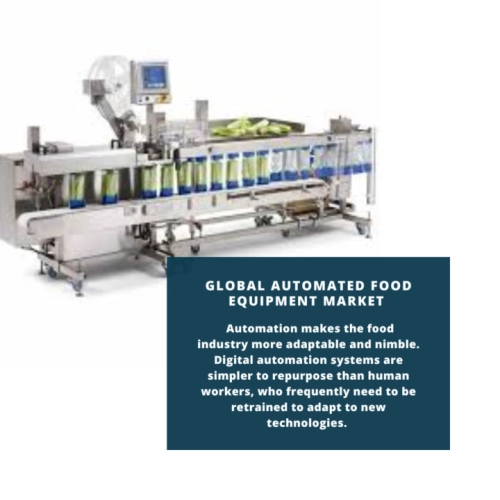
- Get in Touch with Us

Last Updated: Apr 25, 2025 | Study Period: 2022-2030
Automation makes the food industry more adaptable and nimble. Digital automation systems are simpler to repurpose than human workers, who frequently need to be retrained to adapt to new technologies.
If regulations or industry standards change, software or hardware updates can swiftly bring you back into compliance.
Equipment used in production that falls under the topic of industrial automation is utilized to carry out some manufacturing tasks automatically.
Industrial robots, automation cells, conveyors, and unique devices like lifters and turn-over machines are just a few examples of the equipment kinds.
The amount of time that humans spend packaging food and beverages is limited by automated machinery. Furthermore, businesses can enhance logistics and quality as technology develops to become more adaptable and customizable.

The global automated food equipment market accounted for $XX Billion in 2021 and is anticipated to reach $XX Billion by 2030, registering a CAGR of XX% from 2022 to 2030.
GEA introduces Batch2Flow, a sustainable automated system for food processing. GEA has introduced Batch2Flow, a solution that protects the food manufacturing process, conserves water and energy, and uses a great deal fewer cleaning agents.
In this process, it is extremely important to keep the materials at a safe temperature. This helps to guarantee that the ideal viscosity of the meat mixture is maintained during the initial forming process, resulting in successful, flawlessly produced nuggets in addition to helping to avoid spoiling.
However, it consumes a lot of energy and necessitates the use of specially cooled chambers to preserve meat in between the mixing and forming phases of the procedure.
Wokie, a completely automated device for Chinese and Indian cuisines, is introduced by Mukunda Foods. Wokie, a completely automated machine for preparing Chinese, Indian, and Thai food gravies, was introduced by kitchen robotics company Mukunda Foods.
The simple to use and maintain Wokie is a minimal maintenance technology that promotes a reduction in the need for manual labor.
It is IoT-connected for modifying and updating with new updates and is energy-efficient. One can add up to 1000 bespoke recipes that are simple to use simply adhering to the directions for adding components in the quantities, speeds, and temperatures necessary to maintain the desired recipe.
In an exclusive cooperation announced today, Compass Group Canada and SJW Robotics will test three RoWok 24/7 autonomous kitchen robots in a few of their Canadian businesses. The alliance aims to fill a void in food service when warm, fresh, personalised meals are not offered, giving healthcare personnel working nights or students who are taking classes after hours a welcome option.
RoWok is intended to provide a convenient, hot, and fresh meal alternative throughout the day for locations that do not typically have the available footprint for an on-site kitchen or culinary personnel available 24/7.
Using the combined technology of the two businesses, Picnic, a developer of automated pizza-making robots, and Minnow, a maker of food-pickup delivery pods based in Seattle, have launched a new alliance.
The automation of several food preparation and customer-facing processes at a new site enabled by a Picnic and Minnow solution may allow pizza business owners to implement concepts with cheaper costs and smaller footprints.
Miso Robotics, a startup that is using intelligent automation to revolutionise the foodservice sector, has partnered with Lancer Worldwide, a manufacturer of beverage dispensers whose products are trusted by some of the biggest names in the food and beverage industry, to create an automated beverage dispenser powered by intelligence that will improve functionality in a commercial kitchen designed for the future.
| Sl no | Topic |
| 1 | Market Segmentation |
| 2 | Scope of the report |
| 3 | Abbreviations |
| 4 | Research Methodology |
| 5 | Executive Summary |
| 6 | Introduction |
| 7 | Insights from Industry stakeholders |
| 8 | Cost breakdown of Product by sub-components and average profit margin |
| 9 | Disruptive innovation in the Industry |
| 10 | Technology trends in the Industry |
| 11 | Consumer trends in the industry |
| 12 | Recent Production Milestones |
| 13 | Component Manufacturing in US, EU and China |
| 14 | COVID-19 impact on overall market |
| 15 | COVID-19 impact on Production of components |
| 16 | COVID-19 impact on Point of sale |
| 17 | Market Segmentation, Dynamics and Forecast by Geography, 2022-2030 |
| 18 | Market Segmentation, Dynamics and Forecast by Product Type, 2022-2030 |
| 19 | Market Segmentation, Dynamics and Forecast by Application, 2022-2030 |
| 20 | Market Segmentation, Dynamics and Forecast by End use, 2022-2030 |
| 21 | Product installation rate by OEM, 2022 |
| 22 | Incline/Decline in Average B-2-B selling price in past 5 years |
| 23 | Competition from substitute products |
| 24 | Gross margin and average profitability of suppliers |
| 25 | New product development in past 12 months |
| 26 | M&A in past 12 months |
| 27 | Growth strategy of leading players |
| 28 | Market share of vendors, 2022 |
| 29 | Company Profiles |
| 30 | Unmet needs and opportunity for new suppliers |
| 31 | Conclusion |
| 32 | Appendix |